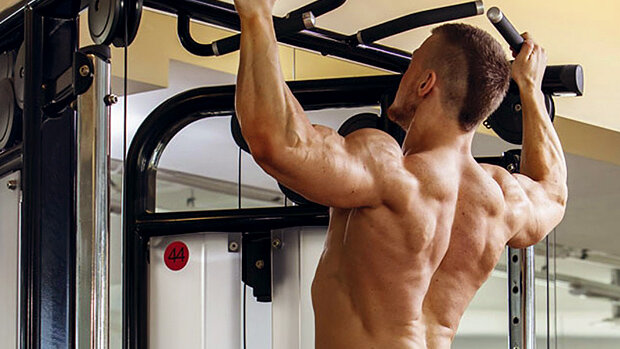Pull-up Common Faults
This is part 2 of a 3 part series about performing safe, strong and effective pull-ups. Check out the first blog post listed under “Pull-up Performance Training.” Written by Jim Skoczen PT, DPT, OCS and owner of Full Circle Performance Physical Therapy.
In the second installment of the pull-up series, we will be discussing how to recognize common faults that can be limiting your performance with this exercise. In my experience as an orthopedic and performance physical therapist, there are a few common issues that clients typically display if they are having pain or limitations with completing pull-ups during workouts.
Elbow Flare
One of the most common mistakes I see with clients having difficulty with pull-ups is letting their elbows flare too far to the side during the pull phase of the exercise. As you can see with the image above, this mohawked bodybuilder is keeping his arms at an angle that is in line with his body. This puts him at a mechanical disadvantage, and makes it much more stressful and difficult on his posterior shoulder, including the muscles of his rotator cuff.
It is more effective to keep your arms at a slightly forward angle that is more in line with the anatomy of your shoulder (see image below). This is a safer and more effective position to work from.
2. Shrug
One the next things I frequently see with clients in the gym, is having an exaggerated shrug at the top most point in the pull. It is really common for clients who are lacking strength at the finish of the movement to do this to completely clear their chin over the bar. This causes your upper trapezius, which is the muscle at the top of your shoulderblades and the back of your neck, to work too hard. This limits the use of your lats, which are stronger and should be the primary mover for this exercise. Fixing this common fault can really lead to improved performance and increased reps. Not too mention helping with tension and pain in your neck!
3. Lost Hollow Body / Horizontal Pull
This is a pretty easy one to spot in the gym. Typically, it involves losing the hollow body (or forward position with your legs) which causes them to hang backwards. Usually this also leads to over-extending your back and pulling more horizontally like a row. In the pic above, you can see the arch in my spine and a position that is pulling the front more than the top of my chest towards the bar.
This is a less efficient and effective way of doing the pull-up because you are relying on your scapular and upper back muscles to do the majority of work versus the much stronger lats. It also places more pressure on your middle and lower back and can lead to some pain or pressure in these areas.
Next time you get in the gym and have pull-ups on the schedule, try to sneak a peak in the mirror or having your lifting partner check out your form. If you notice any of these common faults, try to correct to the positions described in part 1 of this series!
On the next blog post, I’ll be discussing some strengthening and corrective exercises to help you get stronger and more efficient at the strict pull-up, so stayed tuned!
If you have further questions or concerns, contact Full Circle Performance Physical Therapy or stop in for a full evaluation and assessment. The information shared in this post is not intended to be used as medical advice, and I recommend visiting a qualified PT if you need assistance.





